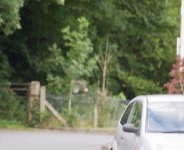It is true that both SEO and LEO both have yellow/buff patches on the upperwings formed by the unbarred base of the outer primaries as shown in the guidebooks. However, in my (humble!) experience of watching flying SEOs, this is not the standout plumage feature that catches the eye of an observer, but rather it is the very dark/black wingtips (opposite to the OP’s observation) and usually very well marked dark carpal patches (as well as the black carpal crescents on the underwing). Long Eared Owls (which admittedly I’ve never seen perched on fences or flying in daylight afair) also have very dark/solid carpal patches which would be the stand out ‘gizz’ plumage feature of a LEO in flight imo.
https://www.youtube.com/watch?v=8_zoBcSrXZk
...but seriously, on this image, we can all agree (including Ellie I think!) that it could be any of the species we’ve mentioned!







